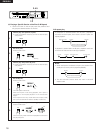
10
ENGLISH
(2) Rear Panel
q
ANALOG OUT (BALANCED) connectors
• These are active balanced outputs using XLR type
connectors.
• Connect these connectors to the balanced analog input
connectors on an amplifier or console.
• Pin layout: 1. Common
2. Hot
3. Cold
• Applicable connector: Cannon XLR-3-31 or equivalent
NOTE: Do not short-circuit the hot or cold pin with the
common pin.
w
ANALOG OUT (UNBALANCED) jacks
• These are unbalanced outputs using RCA type jacks.
• Connect these jacks to the unbalanced analog input jacks
on an amplifier or console.
e
LEVEL L/R controls
• Use these controls to adjust the level of the audio signals
from the ANALOG OUT (BALANCED) connectors.
r
REMOTE connector
• This is a parallel remote connector. Use it to control the
DN-C630 with dry contact circuit connections.
• Applicable connector: 25-pin D-sub (male)
• Connector signal layout:
Pin No. Signal name I/O
1
14
2
15
3
16
4
17
5
18
6
19
7
20
8
21
9
22
10
23
11
24
12
25
13
FG
PLAY tally
PLAY command
PAUSE tally
PAUSE command
CUE tally
CUE command
INDEX 2/INDEX 3 tally
TRACK (+) command
Tally common
TRACK (–) command
Reserved
SEARCH (FWD) command
Reserved
SEARCH (REV) command
Reserved
FADER START command
Tally power supply
Command common
Command common
NC
EOM tally
Reserved
Reserved
Reserved
TTL (lol = 20 mA)
HCMOS (li = 3 mA)
TTL (lol = 20 mA)
HCMOS (li = 3 mA)
TTL (lol = 20 mA)
HCMOS (li = 3 mA)
TTL (lol = 20 mA)
HCMOS (li = 3 mA)
HCMOS (li = 3 mA)
HCMOS (li = 3 mA)
HCMOS (li = 3 mA)
PHOTO COUPLER
+5 V, 20 mA
(li =10 mA)
TTL (lol = 20 mA)
–
O
I
O
I
O
I
O
I
–
I
–
I
–
I
–
I
–
–
–
–
O
–
–
–
NOTE: The tally output pin has open collector IC specifications
(Imax. 20 mA, Vmax. 5 V), but the maximum supply
current is 80 mA, so use with a total load current of 80
mA or less.
t
DIGITAL OUT jack
• This is an unbalanced output using an RCA type jack.
• Connect this jack to the unbalanced digital input jack on
an amplifier or console.
• Signal format: Selectable (See Page 22, 9))
(3) Display Window
q
REPEAT indicator
• This lights when the repeat mode is set.
w
Time mode indicators
• “ELAPSED” lights when the elapsed time is displayed.
• “REMAIN” lights when the remaining time is displayed.
e
Play mode indicators
• “SINGLE” lights when in the single track play mode.
• “TOTAL” lights when in the continuous play mode.
r
Track no. display
• This indicates the track number at the current position.
The track number lights during the track search operation
and when switching to the standby mode.
• If the next track is scheduled, that track number flashes
on the track no. display.
t
Play pause indicator
y
Play indicator
u
Index no. display
• Normally “Tr” is displayed. In the index search mode,
the index number is displayed. If the next index is
scheduled, that index number flashes on the index no.
display. The index number also lights during the index
search operation.
i
Playing position display
• This indicates the current position within the track’s total
playing time.
o
Pitch display
• This indicates the set play speed in %.
!0
Program indicator
• This lights when a program is input.
• This flashes when the PROG. IN mode is set.
!1
20 tracks music calendar
• In the single track play mode, only the specified track
lights.
• In the continuous play mode, everything from the
specified track to the last track lights.
• Track numbers are displayed up to track 20. Tracks 21
and on are not displayed.
!2
Playing time display
• This indicates the time of the current position, in minutes
(m), seconds (s) and frames (f).
!3
Character display
• This displays operation messages in the preset and
program modes.


















